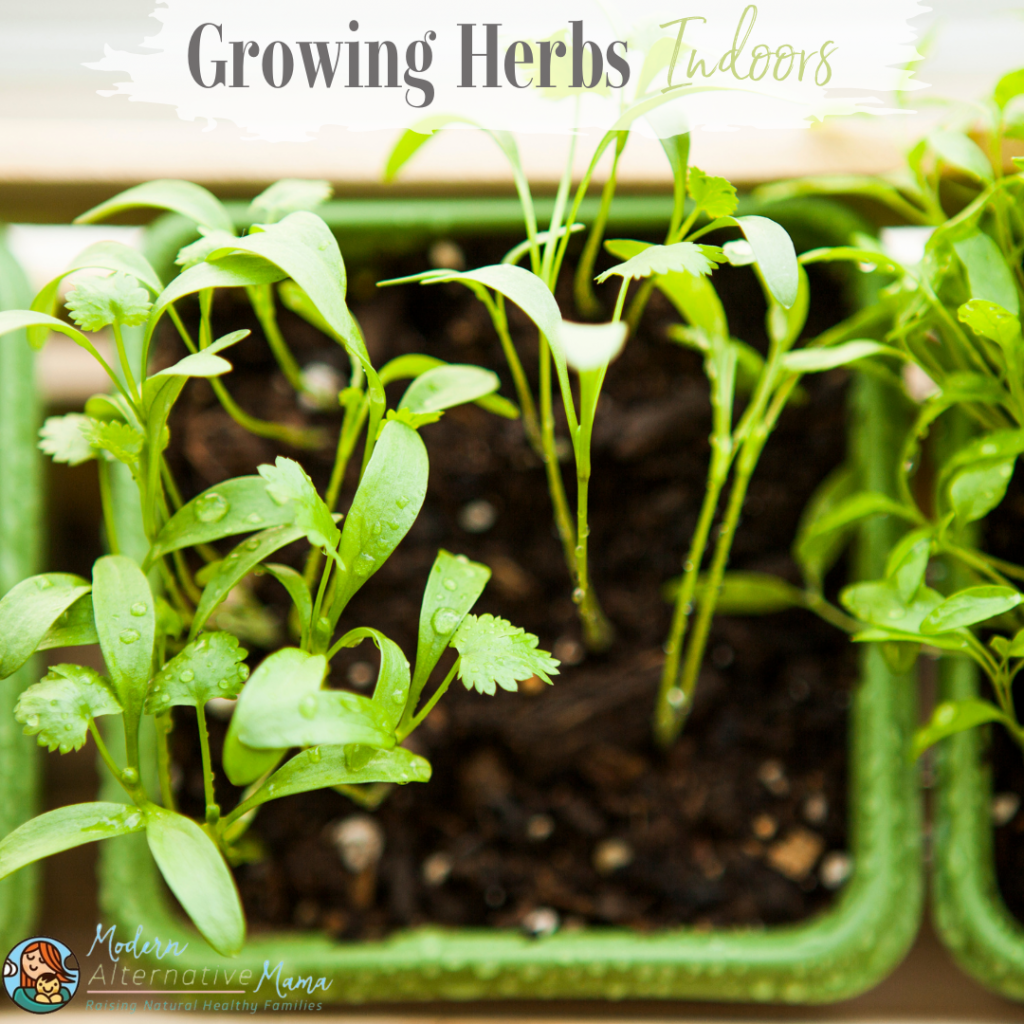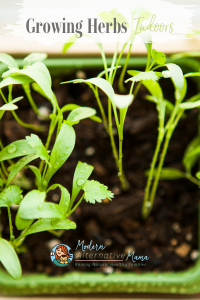As someone who lives in an apartment and is obsessed with cooking whole food plant-based meals, there is nothing more important to me than having fresh organic herbs ready at my disposal.
Taking steps toward self-sufficiency can start right on your windowsill! If you want homegrown food – you can do it, even from an apartment! Of course, gardening takes a lot of time and effort for a project that could fail, but what if it succeeds?
We often think of gardening as an elaborate layout and intensive care for a large plot of ground dedicated to growing flowers, herbs, or vegetables. However, gardening doesn’t have to be super complicated (or even take place exclusively outdoors).
Whether you’re starting an indoor garden because it’s cold where you live or you just don’t have the space outdoors, this blog is for you.
Understanding Herbal Living Conditions
Before you start growing your indoor herbal garden, understanding herbal living conditions is necessary. This section will teach you about their light, temperature, soil, fertilizer, and water requirements. I decided to get the GrowLED LED Indoor Garden to avoid finding the perfect-facing window and take away some of the guesswork as a first-time gardener.
Light
Herbs love direct or indirect sunlight for 6-8 hours daily. Since they love light, if you’re not using indoor lighting, south-facing windows are ideal, as they get the most sunlight throughout the day. Contrarily, north-facing windows are the least ideal as they have the weakest natural sunlight. An east-facing window could be sufficient if there is enough natural sunlight.
Feel free to bring your herbs outside to soak up direct sunlight every once in a while. Direct sunlight will give your herbs a healthy dose of UV light, which they’ll appreciate.
Temperature
If you live in extremely hot or cold climates, be sure your herbs are not touching the window; keep them at least 2 inches away. Extreme temperatures can damage your herbs and even kill them.
Soil
Gardening doesn’t start with a seed; it starts with the soil! You can only have healthy, productive herbs with rich, soft soil that allows the roots to absorb nutrients. Since I am plant-based, I had to dig around quite a bit to find organic potting soil that didn’t contain animal byproducts, so I went with Dr. Earth’s Vegetarian Potting Soil. If that is not a concern for you, I’d recommend Espoma’s Organic Potting Soil.
Fertilizer
Fertilizer promotes healthy herbal growth, but you don’t need to feed herbs as often as other plants. If you choose to use a plant feed, be sure it is made for plants to promote leaf growth, not flower or fruit growth. You could even make your own. After blanching and peeling almonds, I sometimes save the skin to make a plant feed. Since I do that occasionally, I purchased Dr. Earth’s Organic Kelp Meal as a readily available fertilizer. Again, I chose this fertilizer because it was organic and plant-based; if that’s not a concern for you, I’d recommend Jobe’s Organic Herb Plant Food Spikes.
Water
Watering your herbs are simple. You can tell if your herbs need water by putting your finger about an inch deep into the soil. If your finger comes out dry, it’s time to water. If the soil is still moist, leave it alone for a few more days and check again. Overwatering your herbs can result in a breeding ground for mold or fungus.
Also, herbs like humidity, so your herbs may require more water when the heater is on. If your home is particularly dry, place a plate or saucer under the pot with some marbles or rocks, and fill it with water. The humidity from the water pool will help keep your herbs happy.
Herbs to Grow Indoors
One of the simplest ways to start gardening is to grow herbs on a south-facing windowsill. When you’re ready to start your indoor herb garden, there are a few ways to get started. Many stores offer small potted herbs for $2-3. You could also purchase seeds or propagate herbs like lavender, oregano, rosemary, sage, and thyme. Personally, I bought Sereniseed’s 10-Pack of Certified Organic Herb Seeds, which included basil (two variations), chives, cilantro, dill, lavender, oregano, parsley, sage, and thyme. Let’s discuss some of their health benefits.
Basil
Basil is often used in cooking, herbal supplements, and herbal teas. There are many varieties of basil, but the most commonly used are holy basil, sweet basil, Thai basil, cinnamon basil, lettuce basil, and bush or Greek basil. Some benefits of basil include but are not limited to the following:
- Antibacterial properties (1)
- Antifungal properties (2)
- Antimicrobial properties (3)
- May improve fasting blood sugar and diabetes (4)
- May reduce hypertension (5)
- May thin the blood (6)
- May protect against aspirin’s damage to the gut (7)
- May reduce damage from a stroke (8)
- May reduce memory loss and increase mental alertness (9)
- May reduce depression (10)
- Anticancer properties (11)
Chives
Chives are a green vegetable/herb with a mild onion-like flavor. Chives are related to onions and garlic, all members of the allium family. Chives are often used in cooking for their intense flavors and medicinal properties, including, but not limited to:
- Rich in nutrients (12)
- Anti-inflammatory properties (13)
- May support heart health (14)
- May promote eye health (15)
- Anticancer properties (16)
Cilantro
Cilantro is an herb from the fresh leaves and stalks of the coriander plant. Cilantro is a member of the parsley family. Cilantro is often used in cooking but is also well known for its medicinal purposes, including, but not limited to:
- Antioxidant properties (17)
- May reduce anxiety (18)
- May lower blood sugar levels (19)
- Promotes heavy metal detoxification (20)
- May support heart health (21)
- May support brain health (22)
- May support urinary tract health (23)
- Anticancer properties (24)
Dill
Dill is an herb, but there is also a spice known as dill seed; both have a slight licorice flavor and are related to celery. Dill is often used in cooking, such as pickles, eggs, and salad. Still, it’s also brimming with health benefits, including, but not limited to:
- Rich in nutrients (25)
- Antioxidant properties (26)
- Antibacterial properties (27)
- May lower blood sugar levels (28)
- May support heart health (29)
- May promote bone health (30)
- Anticancer properties (31)
Lavender
Lavender is a beautiful herbaceous perennial with purple clusters of flower buds with green-grey leaves between 2-3 feet tall. Lavender has been used in cooking and herbal preparation thanks to its many medicinal purposes, including but not limited to the following:
- May relieve anxiety (32)
- Anti-inflammatory properties (33)
- Wound-healing properties (34)
- May improve eczema, psoriasis, and dry skin (35)
- May improve the appearance of acne, wrinkles, and dark spots (36)
- Promotes hair growth (37)
Oregano
Oregano is an herb from the mint family or the Lamiaceae family. Although there are many different types of oregano, oregano is most commonly used in the herb world thanks to its many medicinal properties, including but not limited to:
- Rich in antioxidants (38)
- Antibacterial properties (39)
- Antimicrobial properties (40)
- Antiviral properties (41)
- Anti-inflammatory properties (42)
- May prevent and kill certain cancers (43)
Parsley
Parsley, sometimes referred to by its scientific name Petroselinum crispum, is a hardy biennial herb of the carrot family. Parsley is commonly used as a garnish and spice. There are two main varieties of parsley: curly leaf and flat leaf. The benefits of parsley include, but are not limited to:
- Rich in nutrients (44)
- Antioxidant properties (45)
- Antibacterial properties (46)
- May support heart health (47)
- May promote eye health (48)
- May promote bone health (49)
- Anticancer properties (50)
Sage
Sage, sometimes referred to by its scientific name Salvia officinalis, is a perennial herb in the mint family. Sage is prized for its strong herbal aroma and earthy flavor. It is used in savory recipes, but it is also brimming with health benefits, including, but not limited to
- Rich in nutrients (51)
- Antioxidant properties (52)
- Antibacterial properties (53)
- May reduce blood sugar levels (54)
- May support heart health (55)
- May support brain health (56)
- May support oral health (57)
- Anti-aging properties (58)
- May provide menopause symptom relief (59)
- Anticancer properties (60)
Thyme
Thyme, sometimes referred to by its scientific name Thymus vulgaris is a Mediterranean herb of the mint family. This herb has small leaves that grow on clusters of thin stems. Thyme is used to season all kinds of dishes and has health benefits such as:
- Rich in nutrients (61)
- Antibacterial properties (62)
- Antifungal properties (63)
- Anti-inflammatory properties (64)
- Mood-regulating properties (65)
- May support heart health (66)
- May support respiratory health (67)
- May promote skin health (68)
- Insecticidal properties (69)
- Anticancer properties (70)








I am in the process of starting Winter tinctures of my still thriving Holy Basil, Gotu Kola, Marshmallow, Dandelion root and Jiaogulan (Chinese adaptogenic herb). Winter may come late here in North Texas, but it still comes and I want to be able to keep my medicinals available through the cold months. Tinctures work great for this.
I will probably start some fresh herbs from seed and keep them under lights starting in December or so. Looking at experimenting with some exotic Chinese and Indian specimens.
If anyone is interested in how to tincture herbs, I just put up a primer on the My Life In The Dirt site.
[…] Continue Reading […]
Thanks for a great post. We love growing herbs indoors, especially thyme and mint. Both do very well on our large picture window that thankfully gets plenty of sun. We also grow quite a bit of basil and parsley. My homeopathic vet recommended the parsley for my dog – so we always keep a ready supply on hand.